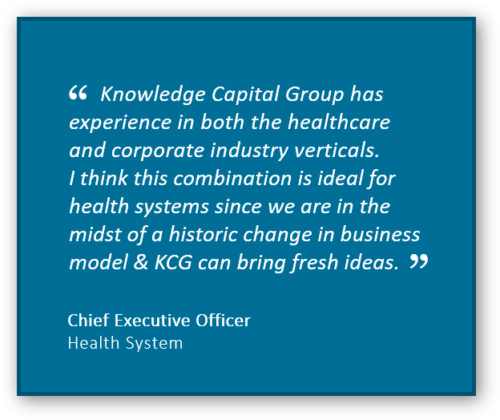Overview
KCG partnered with a regional Academic Health System to develop and implement a strategy for reorganizing its clinical enterprise, so as to drive greater alignment, efficiency and value across care delivery entities.
The Challenge – Silos and the State
KCG’s client is a regional healthcare system serving over one million patients annually throughout coastal South Carolina. With a 700+ bed hospital, an employee base of over 5,000 clinical providers, and a growing network of community hospital and provider affiliates, the Health System had outgrown its historic organizational structure, which aligned physicians by traditional department in the academic and ambulatory care settings, and by patient illness in the hospital. This siloed structure restricted leadership’s ability to make strategic or financial decisions across care delivery entities, realize economies of scale from shared clinical or administrative functions, influence clinical outcomes through coordinated care, or drive transparency to disparate Health System stakeholders.
The leadership team sought to design a new care delivery model that reorganized providers into patient-focused [rather than department-focused] business units spanning the clinical enterprise. But, given the limitations of the Health System’s bylaws and ties to the State, the System could not deploy a framework that directly employed any providers or leveraged ‘solid-line’ reporting relationships. As such, the Health System required a solution that would allow leadership the ability to integrate providers and influence performance without changing existing HR structures.
Approach – Integrated Healthcare

Integrated healthcare is an approach to care delivery that aligns providers across multidisciplinary teams to streamline, facilitate and optimize all aspects of patient care. It is characterized by a high degree of collaboration and coordination to drive outcomes through shared accountability for all patient touch points across the continuum of care. Growing regulatory and revenue pressures have caused many academic healthcare organizations to pursue integration in order to achieve the necessary breadth and depth to manage the comprehensive health of their patients.
For KCG’s client, achieving integration was particularly challenging. Due to its legal structure and relationship with the State, integration would have to rely on functional partnerships across disparate legal entities without clear lines of authority or direct reporting relationships. Using these guardrails as guiding principles, KCG worked with senior leadership on three primary workstreams to develop a structure that would ensure successful integration across the enterprise:
Functional Makeup
KCG worked with clinical leaders to define and develop a matrixed Service Line structure that spanned the continuum of care, aligning providers and clinical services by patient disease or body organ definition. This model maximized multidisciplinary teamwork by integrating providers across traditional clinical specialty groups, recognizing that physicians often work more closely with colleagues in different departments than their own. With greater coordination, transparency and control over quality and value across the continuum – from the patient’s first consult to final follow-up call – this structure better positioned the Health System to succeed under value-based reform initiatives.
Operating Model
To drive operational success of the new Service Line framework, KCG partnered with system utility leaders to centralize and standardize clinical support services, establishing formal protocols and operational mechanisms to ensure seamless integration across Service Line teams. Not only did this new operating model create economies of scale, better allowing the enterprise to accept risks, but it also drove shared accountability for outcomes across physician and operational leaders.
Governance Structure
To ensure leaders were empowered to influence provider performance without abdicating existing reporting relationships, KCG implemented a collaborative goal-setting process that aligned incentives across disparate legal entities. Upon finalizing Service Line goals, KCG worked with analytics SMEs to develop management reports that attributed meaningful quality, financial and operational data to the new organizational structure, arming leaders with the necessary information to manage performance expectations.
Impact
By developing a matrixed framework that facilitated relationships among multidisciplinary clinicians based on patient, rather than department-affiliation, the Health System realized an organizational construct that:
- Established a single, unified approach within the clinical delivery team, better positioning the Health System to provide value-based care
- Better united traditional medical and surgical departments and specialties to deliver a more seamless, consistent patient experience across the continuum
- Drove a transparent, collaborative Health System mentality by reducing fragmentation and competition among physicians in different departments who performed the same procedures
- Furthered strategic priorities by aligning leader goals and incentives across the enterprise, cascaded from meaningful System-level KPI
- Provided the Health System with the capacity for quick and nimble decision-making by deploying a governance model that broke down silos within the clinical enterprise
- Streamlined processes and created economies of scale that allowed the Health System to decrease FTE/AOB by 0.3 from FY16 and 0.14 from budget, resulting in a reduction in labor expense of $26M+ as compared to FY16 and $12M+ as compared to budget
- For the first time, allowed the organization to budget a 4% margin







